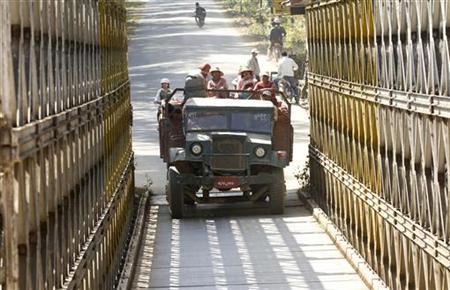Two days of protests at the Indo-Burma border town of Moreh have subsided pending action by the Burmese authorities to ensure the safety of Indians crossing into Burma for trade at the Namphalong market in Tamu, Sagaing Division.
An Indian official told DVB on Monday that trade has almost returned to normalcy.
The protests began on Friday, sparked by the discovery of two mutilated bodies near the Indian village of Jajanonomahai on 20 February.
On 11 February, six Indian nationals entered Burma through the Moreh – Tamu border crossing after obtaining day trade permits from immigration authorities. Four returned the same day; two were said to have been abducted. Moreh immigration officers quickly sent a letter to Burmese authorities urging them to search for the missing traders, and to identify and apprehend their abductors.
Nine days later the Moreh police, who were not allowed to enter Burma to investigate, were informed that the two men’s bodies had been found on the Indian side. The bodies were recovered by the Moreh police with the assistance of Burmese authorities, then moved to Manipur capital Imphal for autopsy.
[related]
Burmese police were not available for comment, though an Indian official told DVB that in a “surprising outcome”, they seem to have “made an effort” to remedy the situation.
Upon discovery of the bodies, community leaders mobilised local residents to blockade the border crossing on the Moreh side, effectively bringing trade to a standstill for two days. Burma and India signed a border trade agreement in 1995, and the movement of mainly Indian and Chinese commodities is the main source of livelihood in the area.
Moreh locals said that despite the obstruction of commerce they supported the protests because they were extremely concerned about their personal safety, as most of them enter Burma almost daily for business. A similar incident occurred in 2013, but neither Indian nor Burmese officials would provide comment on the case.
The protestors have dispersed, according to an Indian official, giving Burmese authorities a chance to respond. Indian daily The Hindu reported on Sunday that demonstrators vowed to resume the blockade if safety could not be guaranteed.
The relationship between India and Burma in Moreh remains otherwise friendly, the official said, though the area has recently been a corner of controversy. Attempts to regulate commercial trade and crack down on what has long been a hotbed of drug and gun-running have necessitated sharpening up boundaries that were casually established in 1972. In so doing, some ethnic villages have been split straight down the middle, while others claim that Burma is inching over into Indian territory.
The people of northeast India – a remote and largely undeveloped region still struggling with conflict between the Indian government and several ethnic separatist movements – depend heavily on cross-border commerce. Regionally referred to as a bandh, commercial obstruction is a popular form of protest in parts of India and Nepal, where general strikes and blocked roads can have immediate and far-reaching impacts on geographically isolated villagers.



